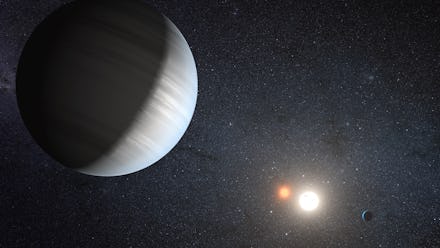College Student Michelle Kunimoto Just Discovered 4 Potential New Planets

A student at the University of British Columbia in Canada just put all of your science projects to shame.
Part of Michelle Kunimoto's coursework involved searching through Kepler Space Telescope data to hunt for signs of planets that scientists may have overlooked. She identified four potential new planets.
One of the planets is Mercury-sized, two are Earth-sized and one is Neptune-sized. The Neptune-sized one, called KOI 408.05, has sparked the most interest. It's the large planet on the right in the illustration below.
"Like our own Neptune, it's unlikely to have a rocky surface or oceans," Kunimoto said in a statement. "The exciting part is that like the large planets in our solar system, it could have large moons and these moons could have liquid water oceans."
That's because KOI 408.05 orbits in the habitable zone around its star where the temperature conditions make it possible for the planet, or its moons, to potentially support life.
Right now these four new planets are "planet candidates" since they'll have to be independently confirmed as actual planets.
The Kepler telescope finds planets by waiting for them to pass in front of their host stars. When that happens, we can see a small dip in the brightness of a star — like what happens when you hold your hand up in front of a flashlight beam. Scientists call this a transit, and we can sometimes observe transits of the planets in our own solar system.
In May, Mercury was visible transiting in front of our sun:
It's easy to see why scientists could miss a few planets using this method of detection. It's especially difficult to find planets that take a long time to orbit their stars since fewer transits will happen in a given amount of time. That's why KOI 408.05 was so difficult to find: it takes the planet 637 days to revolve around its star.
Kunimoto has submitted her findings to the Astronomical Journal.